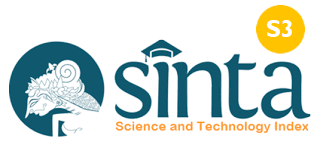Pengembangan Keterampilan Berpikir Tingkat Tinggi Melalui Pendekatan Open-Ended
DOI:
https://doi.org/10.37329/cetta.v3i2.444Keywords:
High order thinking skills; open-ended approachAbstract
Nowadays industrial revolution era, High Order Thinking Skills (HOTS) is part of skills needed to face global rivalry and complex life challenges. However, these skills incline to be little-mastered. It seems to be necessary to develop Higher Order Thinking Skills from the early-ages, especially for students which are integrated in the learning process. This study is a kind of library research. The result of this study showed is the advancement of HOTS can be done through an open-ended approach. The open-ended approach is able to stimulate the students in getting used to think critically, logically, creatively, collusively, argumentating, until decision making in the form of problem solving which contains analyzing, evaluating, and creating activities. Thus, the open-ended approach is well done in the learning process that can support the development of Higher Order Thinking Skills (HOTS)
References
Ariandari, W. P. (2015). Mengintegrasikan Higher Order Thinking dalam Pembelajaran Creative Problem Solving. Seminar Nasional Matematika dan Pendidikan Matematika UNY, (pp. 489-496).
Ariani, I. M. D., Candiasa, I. M., & Marhaeni, A. A. I. N. (2014). Pengaruh Implementasi Open-Ended Problem dalam Pembelajaran Matematika Terhadap Kemampuan Pemecahan Masalah dengan Pengendalian Kemampuan Penalaran Abstrak. e-Journal Program Pascasarjana Universitas Pendidikan Ganesha, 4, pp.
Ariyana, Y., Pudjiastuti, A., Bestary, R., & Zamroni. (2018). Buku Pegangan Pembelajaran Berorientasi pada Keterampilan Berpikir Tingkat Tinggi. Direktorat Jenderal Guru dan Tenaga Kependidikan Kementerian Pendidikan dan Kebudayaan.
Badjeger, R., & Purwaningrum, J. P. (2018). Pengembangan Higher Order Thinking Skills dalam Pembelajaran Matematika di SMP. Guru Tua: Jurnal Pendidikan dan Pembelajaran, 1(1), 36-43.
Biliya A, B. (2015). Penerapan Model Open Ended untuk Meningkatkan Keterampilan Proses dan Hasil Belajar Siswa Kelas V SDN 1 Repaking-Wonosegoro-Boyolali. Scholaria, 5(1), 78-91.
Brookhart, S. M. (2010). How To Asses Higher Order Thinking Skills in Your Classroom. Alexandria: ASDC.
Conklin, W., & Manfro, J. (2010). Higher order Thinking Skills To Develop 21st Century Learners. Inc. Huntington: Shell Education Publishing.
Darmadi, H. (2011). Metode Penelitian Pendidikan. Bandung: Alfabeta.
Dinni, H. N. (2018). HOTS (High Order Thinking Skills) dan Kaitannya dengan Kemampuan Literasi Matematika. Prisma, Prosiding Seminar Nasional Matematika, 1, pp. 170-176.
Heong, Y. M., Othman, W. B., Yunos, J. B., Kiong, T. T., Hasan, R. B., & Mohamad, M. B. (2011). The Level of Marzano Higher Order Thinking Skills. International Journal of Social Science and Humanity, 1(2), 121-125.
Hidayati, A. U. (2017). Melatih Keterampilan Berpikir Tingkat Tinggi dalam Pembelajaran Matematika pada Siswa Sekolah Dasar. Terampil: Jurnal Pendidikan dan Pembelajaran Dasar, 4(2), 143-156.
King, F. J., Goodson, L., & Rohani, F. (2012). Higher Order Thinking Skills. Center for Advancement of Learning and Assessment.
Lahra, A. S., Hasan, M., & Mursal. (2017). Pengembangan Modul Praktikum Berbasis Pendekatan Open Ended untuk Meningkatkan Kreativitas Siswa. Jurnal Pendidikan Sains Indonesia, 5(1), 36-43.
Lestari, N., Hartono, Y., & Purwoko. (2016). Pengaruh Pendekatan Open-Ended Terhadap Penalaran Matematika Siswa Sekolah Menengah Pertama Palembang. Jurnal Pendidikan Matematika, 10(1), 81-94.
Meika, I., & Sujana, A. (2017). Kemampuan Berpikir Kreatif dan Pemecahan Masalah Matematis Siswa SMA. JPPM, 10(2), 8-13.
Muhsinin, U. (2013). Pendekatan Open Ended pada Pembelajaran Matematika. Education Math Journal, 4(1), 46-59.
Sani, R. A. (2016). Penilaian Autentik. Jakarta: Bumi Aksara.
Saputra, H. (2016). Pengembangan Mutu Pendidikan Menuju Era Global: Penguatan Mutu Pembelajaran dengan Penerapan HOTS (HIgh Order Thinking Skills). Bandung: SMILE's Publishing.
Sari, A. N., Wahyuni, R., & Rosmaiyadi. (2016). Penerapan Pendekatan Open-Ended untuk Meningkatkan Kemampuan Berpikir Kritis Siswa pada Materi Aljabar Kelas VIII SMP Negeri 10 Pemangkat. Jurnal Pendidikan Matematika Indonesia, 1(1), 20-24.
Septiani, U., & Zanthy, L. S. (2019). Pembelajaran Matematika Melalui Pendekatan Open-Ended Terhadap Pemahaman Matematik Siswa MTs. Jurnal Cendekia: Jurnal Pendidikan Matematika, 3(1), 28-33.
Soeyono , Y. (2014). Pengembangan Bahan Ajar Matematika dengan Pendekatan Open-Ended. PYTHAGORAS: Jurnal Pendidikan Matematika, 9(2), 205-218.
Supadmini, N. K., Wijaya, I. K. W. B, & Larashanti, I. A. D. (2020). Implementasi Model Pendidikan Lingkungan UNESCO Di Sekolah Dasar. Cetta: Jurnal Ilmu Pendidikan, 3(1), 77-83.
Suwandi, T., Hasnunidah, N., & Marpaung, R. R. T. (2016). Pengaruh Pembelajaran Berbasis Masalah Open-Ended Terhadap Peningkatan Kemampuan Pemecahan Masalah Oleh Siswa. Jurnal Pendidikan Progresif, 6(2), 163-173.
Wijaya, I. K. W. B. (2020). Pengembangan Kompetensi 4C dan Keterampilan Proses Sains Melalui Pembelajaran Berbasis Catur Pramana. Guna Widya: Jurnal Pendidikan Hindu, 7(1), 70-76.
Downloads
Published
How to Cite
Issue
Section
License
An author who publishes in the Cetta : Jurnal Ilmu Pendidikan agrees to the following terms:
- Author retains the copyright and grants the journal the right of first publication of the work simultaneously licensed under the Creative Commons Attribution-ShareAlike 4.0 License that allows others to share the work with an acknowledgement of the work's authorship and initial publication in this journal
- Author is able to enter into separate, additional contractual arrangements for the non-exclusive distribution of the journal's published version of the work (e.g., post it to an institutional repository or publish it in a book) with the acknowledgement of its initial publication in this journal.
- Author is permitted and encouraged to post his/her work online (e.g., in institutional repositories or on their website) prior to and during the submission process, as it can lead to productive exchanges, as well as earlier and greater citation of the published work (See The Effect of Open Access).
Read more about the Creative Commons Attribution-ShareAlike 4.0 Licence here: https://creativecommons.org/licenses/by-sa/4.0/.





